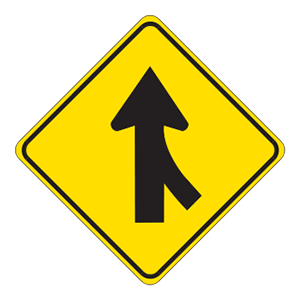2025 Oregon Permit Test 8
The following questions are from real DMV written tests. These are some of the actual permit questions you will face in Oregon. Each permit practice test question has three answer choices. Select one answer for each question and select "grade this section." You can find this button at the bottom of the drivers license quiz. For a complete list of questions and answers for Oregon please visit https://cheat-sheets.dmv-written-test.com/en/oregon/car.
Number of Tests
Number of Question
Passing Score
1. This sign means:

Explanation
Warning signs prepare drivers for upcoming road conditions and hazards and are usually yellow with black markings. This sign alerts drivers to potential traffic merging from the right. Drivers should prepare to allow the traffic to merge safely.
2. What does it mean when you see amber lights flashing on a school bus?
Explanation
Flashing amber lights on a school bus warn that the bus is about to stop to load or unload children. If you see these lights, prepare to stop for the bus. When its red lights flash, come to a stop before reaching the bus and remain stopped until the red lights stop flashing.
3. When driving on slippery roads, you should:
Explanation
On slippery roads, you should increase your following distance. It may take more time to stop your vehicle than it would under normal conditions.
4. A solid yellow line on your side of the centerline means:
Explanation
A solid yellow line next to your lane means that passing is not permitted from your direction.
5. As a driver, you must stop at an intersection for a pedestrian:
Explanation
You must stop for pedestrians crossing the road at any marked or unmarked crosswalk. Yield the right-of-way and proceed when the crosswalk is clear.
6. Which of the following lights indicates that you should slow down and proceed with caution at an intersection?
Explanation
A flashing yellow traffic light at an intersection indicates that drivers must slow down, proceed with caution, and be prepared to stop.
7. Drivers who eat and drink while driving:
Explanation
